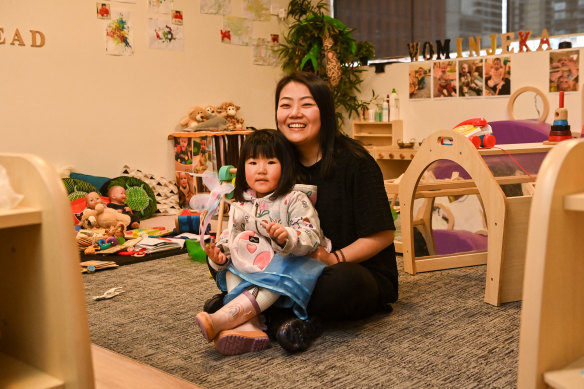This was published 10 months ago
The best and worst places to access childcare in Victoria
By Alex Crowe
Families living in Melbourne’s city centre have access to more than three times the number of childcare places as those living in parts of the city’s suburban north, new research shows, while some of the state’s fastest growing regions are struggling to keep up with rising demand.
Analysis of federal government data by Victoria University’s Mitchell Institute showed some parts of the state had no available places – the so-called “childcare deserts” – while other areas had more spots than there were children.

Savannah Sun retrained to become an early learning educator and now works at Kids on Collins, where her daughter, Sylvie Wang, attends.Credit: Justin McManus
It also found that money matters: government policies and incentives have played an important role in improving childcare accessibility nationwide over the past four years, but poorer areas were disadvantaged.
“Where services are covered by the Child Care Subsidy, providers are more likely to operate in more affluent areas as they can increase their revenue opportunities through a share of the subsidy,” the report found.
The data showed there were 0.954 childcare places for every child living in the Melbourne CBD-east statistical area in 2024, compared with just 0.299 places for people living in Fawkner in the city’s north.
Families in Melton West – in a local government area expected to grow by 93 per cent by 2036 – had 0.452 places per child available to them, while nearby Cobblebank had 0.342 places. In St Kilda, which is among the suburbs where population had declined at the most recent census, families had 0.738 places per child available to them, while St Kilda East had 0.810.
Access to childcare varied greatly in regional areas, with some Victorians living in what researchers termed childcare deserts – where there were more than three children per childcare place.
Nationwide, more than 700,000 Australians were living in childcare deserts with virtually no childcare services available.
The Benalla region in the state’s north-east had no childcare available and was ranked the worst in Victoria for access. Meanwhile, the Ararat region – in the Central Highlands west of Melbourne – had the most childcare places available in the state, with 1.177 places per child.
Early childcare educator Savannah Sun travels from her home in Blackburn (0.754 places per child) to work in the Melbourne CBD West (0.886 places).
She retrained as an early learning educator and is now helping educate her daughter, Sylvie Wang, at Kids on Collins.
“Being able to spend all day with them, for me, it is a really good experience,” she said.
During the federal election campaign, the Albanese government promised to increase childcare subsidies for all families earning up to $530,000 and extend the increased subsidies to outside school hours care.
It is now considering its response to a Productivity Commission report that recommended changes to the childcare subsidy and market intervention to improve accessibility.
A Victorian government spokesperson said it was establishing 50 affordable state-owned early learning centres in areas that needed them most, with the first to 30 to be opened by 2028.
“Importantly, 28 centres will be located in regional Victoria, helping to meet local demand for kindergarten and childcare in our regional communities,” they said, adding the Allan government would continue to advocate for increased federal funding for childcare.
The Mitchell Institute study, International childcare report: Mapping the deserts, followed a similar research project it conducted in 2022.
The research shows that the number of childcare places in Australia has increased by about 70,000 between 2020 and 2024.
Childcare accessibility improved in Victoria over the past four years. In 2020, about 23 per cent of regions in the state were classified as a childcare desert but by 2024, this had dropped to 14 per cent. Nationwide, it has fallen from 34 per cent of regions to 24 per cent over the same period.
However, the data showed the gap between rural and metropolitan Australia had continued to grow.
The international study looked at childcare access for about 10 million children across nine nations. Australia ranked fourth out of the countries involved.
Sweden and Norway enjoyed some of the greatest and fairest access to childcare, regardless of affluence levels.
Associate Professor Peter Hurley, the Mitchell Institute director, said it was now possible to see the impact of different government policies and how nations compared.
“The results will affect the lives of millions of families around the world,” he said.
The international section of the report, including specific data and lead table on the United Kingdom, Scotland, France, Netherlands, Norway and Sweden, will be released in full in early September.
Start the day with a summary of the day’s most important and interesting stories, analysis and insights. Sign up for our Morning Edition newsletter.